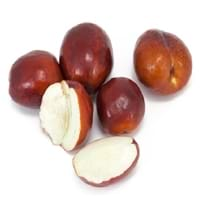Health Benefits
Cancer prevention, Cures gastro-intestinal troubles, Heart care, Muscle pain relief, Prevents blindness from diabetes
Cancer prevention, Diarrhea treatment, Improves muscular strength, Liver health, Maintains hormonal balance, Reduces nervous tension, Reduces blood circulation problems, Reduces stress, Regulation of heart rate, Treatment of hysteria
General Benefits
Boosts immune system, Digestive aid, Fights against infections, Helps in weight loss, Maintains healthy cholesterol level, Strengthens bones
Anti oxidant properties, Digestive aid, Flu treatment, Helps in weight loss, Strengthens bones, Treatment of common cold
Skin Benefits
Anti-aging benefits, Skin rejuvenation
Heals sunburn, Hydrates skin, Reduces wrinkles, Skin rejuvenation, Skin revitalization
Hair Benefits
Promotes longer and healthier hair, Protects hair
Promotes longer and healthier hair, Protects hair
Allergy Symptoms
Coughing, Diarrhea, Headaches, Hives, Itching, Labored Breathing, Nausea, Runny nose, Swelling of mouth, tongue or lips, Vomiting, Watery eyes
Abdominal pains, Breathing difficulty, Diarrhea, Hives, Itching in eyes, Itching of nose, Nasal congestion, Redness of eyes, Runny nose, Sneezing, Wheezing
Side Effects
May cause abdominal pain, Diarrhoea, Mouth irritation, Throat irritation, Weight gain
Decrease in blood sugar levels, Intense headache
Lactating Women
Yes
Not Available
Best Time to Eat
As a snack in the late afternoon, Don't consume at night and before bed, Eat the fresh ones, avoid mixing with any other foods, don't eat after meal., Morning time (before lunch), Strictly avoid empty stomach
As a snack in the late afternoon, Don't consume at night and before bed, Morning time (before lunch), Strictly avoid empty stomach
Vitamin B5 (Pantothenic Acid)
Not Available
Vitamin B9 (Folic acid)
Not Available
Vitamin C (Ascorbic Acid)
Vitamin E (Tocopherole)
Not Available
Vitamin K (Phyllochinone)
Not Available
Lutein+Zeaxanthin
Not Available
Calories in Fresh Fruit with Peel
Not Available
Calories in Fresh Fruit without Peel
Not Available
Calories in Frozen Form
Not Available
Calories in Canned Form
Not Available
Calories in Juice
Not Available
Calories in Jam
Not Available
Calories in Pie
Not Available
Type
Tree fruit, Tropical
Tree fruit
Season
Spring, Summer
Autumn, Summer
Varieties
Emperor fruit, Mauritiu, Sweet Heart, Brewster, Haak Yip and Bengal
Honey Jar, Sugar Cane, Li, Shanxi Li, Sherwood, Chico, Silverhill, Tigertooth, Winter Delight and Lang
Color
Bright red, Pink red
Green, Red, Yellow
Inside Color
Greyish-white
White
Taste
Crunchy, Juicy, Sweet
Sweet
Origin
China, Indonesia, Philippines, Vietnam
Syria
Soil Type
Alluvial, Loam, Well-drained
Sandy, Well-drained
Climatic Conditions
Absence of strong wind, Cold, Dry, Without frosts
Warm to hot climate
Facts about
- The seed of Lychee fruit is toxic & can adversely affect the digestive system.
- This fruit gives a smoky flavor when eaten dried.
- This fruit is a symbol of love and romance in China.
- Pigment extracted from Indian jujube is used for silk dyeing in Burma.
- In Korea, jujube wood is used to make wind instrument taepyeongso.
- Fresh jujube is known as Chinese apple & dried form is called as Chinese date.
Other Countries
Australia, India, South Africa, Thailand, United States of America
Bangladesh, India, Iran, Korea, Lebanon, Pakistan
Top Importer
Hong Kong
United States of America
Botanical Name
Litchi chinensis
Ziziphus zizyphus
Synonym
Nephelium litchi
Ziziphus jujuba or Ziziphus mauritania or Zizyphus jujuba
Subkingdom
Tracheobionta
Tracheobionta
Division
Magnoliophyta
Magnoliophyta
Class
Magnoliopsida
Magnoliopsida
Family
Sapindaceae
Rhamnaceae
Species
L. chinensis
Z. zizyphus
Generic Group
Soapberry
Not Available
Difference Between Lychee and Jujube
We might think that Lychee and Jujube are similar with respect to nutritional value and health benefits. But the nutrient content of both fruits is different. Lychee and Jujube Facts such as their taste, shape, color, and size are also distinct. The difference between Lychee and Jujube is explained here.
The amount of calories in 100 gm of fresh Lychee and Jujube with peel is Not Available and 79.00 kcal and the amount of calories without peel is 66.00 kcal and Not Available respectively. Thus, Lychee and Jujube belong to Low Calorie Fruits and High Calorie Fruits category.These fruits might or might not differ with respect to their scientific classification. The order of Lychee and Jujube is Sapindales and Rosales respectively. Lychee belongs to Sapindaceae family and Jujube belongs to Rhamnaceae family. Lychee belongs to Litchi genus of L. chinensis species and Jujube belongs to Ziziphus genus of Z. zizyphus species. Beings plants, both fruits belong to Plantae Kingdom.









